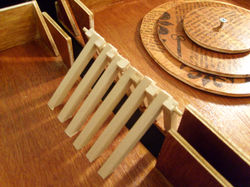
ALVIN ASHBY JR
Epiphanies
A collection of artistic "stories" told through physical and visual mediums.
 |  |
|---|---|
 |  |
 |
The Clavis Dominus
An epiphany is described as the sudden realization or comprehension of a larger essence or meaning of something; it illuminates a deeper or numinous foundational frame of reference…
The ancient Egyptians, Greeks, and Romans all wondered about the great phenomena that occurred in the earth. Some cultures sought to explain these things through religion, others tried to rationalize such events through science and math. In either case, the methodologies and findings of ancient times helped current scientists and mathematicians understand some of the wonders of the world. But such knowledge, mystery and discovery had to be stored somehow…something had to connect the vast information that humans around the world were discovering.
The first historical proof of such a thing comes from Egypt where historians have a vast understanding of the history there. King Ptolemy V (reigned 204–181 BC) kept a personal “diary” (by modern standards) which officially documents the start of what is now known as the Clavis Dominus or master key. In this simple papyrus codex Ptolemy had writings where he documents how he learned the ancient Greek lettering. King Ptolemy also wrote down the full version of the Rossetta Stone within this codex. Among other secret writings he also kept the original plans of the Great Pyramids and Sphinx. It is unclear how the simple collection of notes came into the possession of Horace of Rome but it is clear that he was the first to officially name the collection Clavis Dominus.
Much of the books whereabouts are clouded even more until it reappears in history over a thousand years later when Leonardo da Vinci came into possession of the collection of great writings and decoders it gained along the way. Da Vinci was the first to enclose the collection into a protective box. Based upon his Vitruvian Man findings he wanted the Clavis Dominus to be a very proportional box. Leonardo wanted the box to be 1/6 of a cubit by 1/6 of a cubit or a foot by foot. He added a small easel inside of the box that he could use to draw and paint upon. Much of Da Vinci’s near impossible knowledge is attributed to his discovery of the Clavis Dominus. After his death the Clavis found its way to Hernan Cortes who fashioned an impressive compass to the inside of the box; during his conquest of Central America, the declining Aztecs gained possession of it and made a series of small glass pyramids which they placed atop the box. Since then this mysterious and vastly powerful box has found its way into my possession…
One day the Clavis Dominus will vanish from my possession and find a new holder; whoever it finds will discover the modifications I have added to it and hopefully they will aid the new user in furthering the Clavis’s content. New moments and epiphanies occur each day…will you be ready to add them if the Clavis Dominus chooses you?
 |  |
|---|---|
 |  |
 |  |
Meandering Moments
This installation is a 3D collage of pictures I took in Barcleona, Spain. The three cubes are in the shape of the "Ejiample" gridded portion of the city. Photo film meanders around and through the cubes, this represents the random paths I took throughout the city and the discoveries I captured on film.
Montserrat
A short film I created after visiting Montserrat in Spain. Montserrat is a beautiful multipeaked mountain in the middle of the Spanish countryside. After visiting the mountain range, I felt inspired to tell this story through film.
The Tesseract
The Tesseract is an ongoing project of mine to create a new musical instrument. Part art and part enginnering, The Tesseract attempts to add a fourth dimension to instrument playing and design.